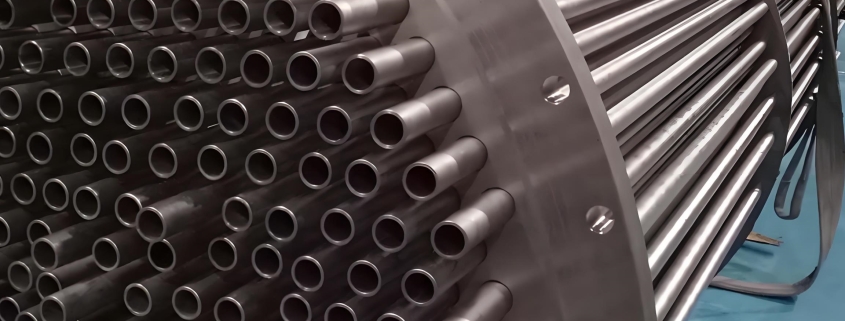Miksi kylmävedettyjä saumattomia putkia käytetään kattiloissa ja lämmönvaihtimissa?
Johdanto
Kattiloilla ja lämmönvaihtimilla on keskeinen rooli tehokkaassa lämmönsiirrossa teollisuudenaloilla, kuten sähköntuotannossa, kemiallisessa käsittelyssä ja öljynjalostuksessa. Näiden komponenttien suorituskyky, luotettavuus ja käyttöikä riippuvat suuresti materiaalien laadusta. Yksi jatkuvasti erottuva materiaali on kylmävedetyt saumattomat putket. Tämä blogi selittää, miksi nämä putket ovat suositeltavia tällaisissa vaativissa sovelluksissa, keskittyen niiden ominaisuuksiin, etuihin ja siihen, kuinka ne käsittelevät kattila- ja lämmönvaihdinjärjestelmien yleisiä huolenaiheita.
1. Kylmävedettyjen saumattomien putkien ymmärtäminen
Kylmävedetyt saumattomat putket valmistetaan monivaiheisella prosessilla, jossa kiinteä aihio vedetään karan päälle ontto putken luomiseksi. Toisin kuin hitsatuissa putkissa, niissä ei ole hitsausliitoksia, mikä johtaa yhtenäiseen rakenteeseen, jolla on erinomaiset mekaaniset ominaisuudet. Termi "kylmäveto" viittaa putken halkaisijan ja paksuuden pienentämiseen huoneenlämpötilassa, mikä parantaa sen lujuutta ja pinnan viimeistelyä.
Ominaisuudet:
- Saumaton rakentaminen: Ei hitsejä tai liitoksia, joista voi tulla vikakohtia.
- Kylmäpiirustusprosessi: Parantaa mekaanisia ominaisuuksia ja pinnan laatua.
- Muokattavat mitat: Erittäin tarkka seinämän paksuus, halkaisija ja pituus.
2. Miksi kylmävedetyt saumattomat putket ovat etusijalla kattiloissa?
Kattilat toimivat äärimmäisissä lämpötila- ja paineolosuhteissa, ja ne vaativat materiaaleja, jotka kestävät lämpörasitusta, korroosiota ja eroosiota. Kylmävedetyt saumattomat putket tarjoavat useita etuja, jotka tekevät niistä sopivia näihin ympäristöihin:
2.1. Ylivoimainen vahvuus
Kylmävetoprosessi lisää putkien vetolujuutta ja kovuutta, jolloin ne kestävät paremmin muodonmuutoksia korkeassa paineessa. Tämä on erityisen tärkeää kattiloissa, joissa putkien on säilytettävä rakenteellinen eheys vaihtelevista sisäisistä paineista huolimatta.
2.2. Korkea lämmönkestävyys
Kattilat käyvät läpi nopeita lämmitys- ja jäähdytysjaksoja, jotka aiheuttavat lämpörasitusta putkissa. Kylmävedetyissä saumattomissa putkissa on homogeeninen mikrorakenne, mikä varmistaa tasaisen lämmön jakautumisen ja minimoi lämpöväsymisestä johtuvan halkeamien tai rikkoutumisen riskin.
2.3. Korroosionkestävyys
Vesi ja höyry voivat aiheuttaa korroosiota kattiloissa, mikä johtaa vuotoihin ja tehon heikkenemiseen. Monet kylmävedetyt saumattomat putket on valmistettu korroosionkestävistä seoksista, kuten ruostumattomasta teräksestä tai korkean lämpötilan nikkeliseoksista, jotka kestävät korroosiota aiheuttavia ympäristöjä voimalaitoksissa ja teollisuuskattiloissa.
2.4. Parannettu pitkäikäisyys
Saumattomissa putkissa on vähemmän vikoja, kuten sulkeumia tai epäpuhtauksia, jotka voivat heikentää materiaalia ajan myötä. Tämä pidentää käyttöikää ja vähentää korjauskatkoksia, mikä parantaa kattilajärjestelmien yleistä toimintatehokkuutta.
3. Kylmävedettyjen saumattomien putkien rooli lämmönvaihtimissa
Lämmönvaihtimet siirtävät lämpöä nesteiden välillä ilman suoraa kosketusta niiden välillä. Lämmönvaihtimien putkien tulee tarjota tehokas lämmönjohtavuus, kestää korkean paineen ympäristöjä ja kestää korroosiota.
3.1. Lämmönjohtavuus
Kylmävedetyissä saumattomissa putkissa on usein sileä ja tasainen pinta, mikä parantaa lämmönsiirtotehokkuutta. Sovelluksissa, kuten höyrylauhduttimissa ja kuori- ja putkilämmönvaihtimissa, parannettu pintakäsittely vähentää saostumien muodostumista ja varmistaa optimaalisen lämmönvaihdon.
3.2. Mittojen tarkkuus
Lämmönvaihtimet vaativat putkia, joissa on tarkat seinämän paksuus- ja halkaisijatoleranssit tehokkaan nestevirtauksen ja lämmönsiirron ylläpitämiseksi. Kylmävetoprosessi tarjoaa suuren mittatarkkuuden, mikä varmistaa, että putket sopivat tiiviisti vaihtimeen ilman rakoja, jotka voisivat heikentää tehokkuutta.
3.3. Likaantumisen ja hilseilynkestävyys
Kylmävedetyt saumattomat putket, erityisesti ne, jotka on valmistettu runsasseosteisista materiaaleista, kuten ruostumattomasta teräksestä, kestävät likaantumista ja hilseilyä – yleisiä ongelmia, jotka vähentävät lämmönvaihtimien tehokkuutta. Kylmävetoprosessin tuottamat tasaisemmat pinnat vähentävät myös hiukkasten ja hilseilyn tarttumista, mikä helpottaa huoltoa ja puhdistusta.
3.4. Kestävyys syklisessä kuormituksessa
Lämmönvaihtimet ovat usein alttiina syklisille painevaihteluille. Kylmävedetyt saumattomat putket ovat paremmin varustettuja selviytymään näistä olosuhteista korkeamman myötörajan ja paremman väsymiskestävyyden ansiosta, mikä varmistaa vähemmän putkivikoja.
4. Yleisten ongelmien ratkaiseminen kylmävedetyillä saumattomilla putkilla
Ottaen huomioon niiden ratkaisevan roolin korkean suorituskyvyn järjestelmissä, on luonnollista, että käyttäjät ovat huolissaan kylmävedettyjen saumattomien putkien suorituskyvystä ja luotettavuudesta. Alla on joitakin ratkaisuja ja ohjeita yleisiin ongelmiin.
4.1. Huoli: Materiaalin valinta
Sopivan materiaalin valinta on ratkaisevan tärkeää kattiloiden ja lämmönvaihtimien suorituskyvyn kannalta. Ruostumattomia teräksiä, hiiliteräksiä ja nikkeliseoksia käytetään yleisesti kylmävedetyissä saumattomissa putkissa. Ruostumaton teräs (esim. SS 316) tarjoaa erinomaisen korroosionkestävyyden syövyttävissä ympäristöissä. Nikkelipohjaiset seokset (esim. Inconel) ovat usein edullisia korkeissa lämpötiloissa.
4.2. Ongelma: Korroosiosta johtuva putkivika
Vaikka kylmävedetyt saumattomat putket kestävät korroosiota, tietyt ympäristöt, kuten kloridit sisältävät ympäristöt, voivat silti aiheuttaa paikallista korroosiota. Ratkaisuja ovat sopivan metalliseoksen valinta ja suojapinnoitteiden levittäminen tarvittaessa. Säännöllinen tarkastus ja huolto ovat myös tärkeitä korroosion varhaisten merkkien havaitsemiseksi.
4.3. Huoli: Toiminnallinen seisokki
Sähköntuotannon kaltaisilla aloilla putken vaihto tai korjausseisokit voivat olla kalliita. Kylmävedetyt saumattomat putket vähentävät toistuvan huollon tarvetta, koska ne kestävät paremmin ja kestävät yleisiä kulumismekanismeja, kuten korroosiota ja eroosiota, minimoiden yleisen käyttökatkoksen.
4.4. Huoli: Kustannustehokkuus
Vaikka kylmävedetyillä saumattomilla putkilla voi olla korkeammat alkukustannukset kuin hitsatuilla vaihtoehdoilla, niiden pidempi käyttöikä, parantunut luotettavuus ja pienemmät huoltotarpeet johtavat alhaisempiin elinkaarikustannuksiin. Pitkän aikavälin käyttökustannuksia arvioitaessa saumattomien putkien käyttö osoittautuu usein kustannustehokkaammaksi.
5. Johtopäätös
Kylmävedetyt saumattomat putket tarjoavat vertaansa vailla olevan lujuuden, lämmönkestävyyden ja korroosiosuojauksen yhdistelmän, mikä tekee niistä ihanteellisen valinnan eri teollisuudenalojen kattiloihin ja lämmönvaihtimiin. Niiden ylivoimaiset mekaaniset ominaisuudet, korkea tarkkuus ja kestävyys varmistavat, että ne kestävät näiden järjestelmien vaativia olosuhteita, mikä parantaa tehokkuutta ja vähentää huoltotarvetta.
Investoimalla kylmävedettyihin saumattomiin putkiin teollisuudenalat voivat saavuttaa erinomaisen toimintavarmuuden ja pidentää kriittisten laitteidensa käyttöikää, mikä johtaa lopulta kustannusten alenemiseen ja parempaan suorituskykyyn ajan myötä. Suunnittelet sitten kattilaa tai lämmönvaihdinjärjestelmää, kylmävedettyjen saumattomien putkien valitseminen on strateginen päätös, joka maksaa sekä suorituskyvyn että pitkäikäisyyden.




